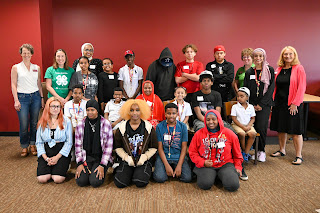By Marisa Coyne & Madeline Eaton
One year ago, I wrote a blog titled Equity-informed volunteer recognition: Three shifts in practice, suggesting that youth serving organizations with a commitment to equity and inclusion should evaluate their volunteer recognition practices with the goal of moving away from using exclusively tenure and status-based appreciation methods.
Drawing on Tema Okun’s work on dismantling racism in institutions, I suggested three shifts in formal volunteer recognition practices.
- Focus volunteer impact over volunteer tenure
- Celebrate many volunteers rather than few
- Explore online recognition in addition to in-person events
One year later, our youth serving organization has implemented some of these practices in our formal, statewide volunteer recognition program. I’m back to report our results and share our learning.
We developed and launched Northern Lights, a volunteer recognition focused on the impacts made by volunteers, regardless of their tenure with our organization. We also invited nominations from teams of volunteers working together to create learning and leadership opportunities for young people. Finally, we encouraged nominations of screened volunteers as well as adult helpers who work under the leadership of screened and approved volunteers.
Using a simple nomination form that took no more than 15 minutes to complete, we encouraged nominations of volunteers who:
- Welcome our youngest youth and families through designing and delivering public programming for kindergarten through second grade
- Create learning environments for older youth (ages 12 - 18) that improve their self-concept, personal agency, resilience and community connectivity
- Champion diversity, equity, inclusion and accessibility by creating spaces of belonging and empowerment for Minnesota youth of all identities
We advertised the volunteer recognition program and distributed the nomination form to colleagues, volunteers, and community partners through internal and external newsletters, websites, and meeting announcements.
When nominations closed, we had received four times the number of nominations received in the previous two years - many featuring volunteers in their first few years with our program. As we anticipated, the submissions were closely aligned with our organization’s strategic goals and objectives, included solo volunteers and teams of volunteers, and centered around the incredible impact that volunteer youth workers can have in their local communities.
During National Volunteer Week, we published a volunteer impact story series based on the nominations we received. We wrote about Felicia, a volunteer youth worker who is deaf, and her work to design and teach a class on American Sign Language for hearing youth. We shared about Rachel and Julie, a volunteer team committed to ensuring that young people of all abilities have an opportunity to learn about and ride horses. We told the story of Ace, a video production company founder, inspired to help young people tell their own stories through photo and video. We shared about Hanan and Mohamed’s commitment to youth empowerment and their homework help work with a primarily immigrant youth population. You can read the full story series on our youth development news page.
Early results are already proving promising. The stories are being shared on social media, forwarded to stakeholders and community partners, and used internally to illustrate the role volunteer youth workers play in creating high-quality, culturally responsive learning environments and opportunities. What’s clear is that recognizing volunteer impact, regardless of tenure and flexing nomination processes to allow for nominations of teams and partners, inspires nominations of diverse volunteers with a desire to impact their local communities.
Do you use volunteers and community members to achieve your program's mission? Do you approach volunteer recognition with equity in mind? What changes have you made to your volunteer recognition practices over the last year?
-- Marisa A. Coyne, Extension educator and volunteer systems director
-- Madeline Eaton, Senior communications specialist
You are welcome to comment on this blog post. We encourage civil discourse, including spirited disagreement. We will delete comments that contain profanity, pornography or hate speech--any remarks that attack or demean people because of their sex, race, ethnic group, etc.--as well as spam.

It is so exciting to see how immediate the results were of these shifts! Thank you for being so intentional about researching the kinds of changes needed, implementing them, and measuring the impact. This is really tangible, do-able, hopeful progress!
ReplyDelete